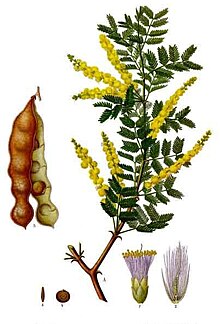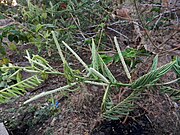Senegalia senegal
| Senegalia senegal | |
|---|---|

| |
| Scientific classification | |
| Kingdom: | Plantae |
| Clade: | Tracheophytes |
| Clade: | Angiosperms |
| Clade: | Eudicots |
| Clade: | Rosids |
| Order: | Fabales |
| Family: | Fabaceae |
| Subfamily: | Caesalpinioideae |
| Clade: | Mimosoid clade |
| Genus: | Senegalia |
| Species: | S. senegal
|
| Binomial name | |
| Senegalia senegal (L.) Britton
| |
| Synonyms[1] | |
| |
Senegalia senegal(also known asAcacia senegal) is a smallthornydeciduous tree from the genusSenegalia,which is known by several common names, includinggum acacia,gum arabic tree,Sudan gumandSudan gum arabic.In parts of India, it is known asKherorKhor.[2]It is native to semi-desert regions ofSub-Saharan Africa,as well asOman,Pakistan,and west coastalIndia.It grows to a height of 5–12 metres (16-40'), with a trunk up to 30 cm (1') in diameter.[3]Sudanis the source of the world's highest qualitygum arabic,known locally ashashab gumin contrast to the related, but inferior, gum arabic fromRed acaciaor talah gum.[4]
Uses
[edit]Gum arabic
[edit]The tree is of great economic importance for thegum arabicit produces which is used as afood additive,in crafts, and as acosmetic.The gum is drained from cuts in the bark, and an individual tree will yield 200 to 300 grams (7 to 10 oz). Eighty percent of the world's gum arabic is produced inSudan.[5] TheChauhatanarea of Barmer district inRajasthanis also famous for gum production, this is called कुम्मट[6](Kummat) in local language there.
Forage
[edit]New foliage is very useful asforage.[7]Leaves and pods ofS. senegalare browsed by domestic and wild ruminants.[8]
Agriculture
[edit]Like other legume species,S. senegalfixes nitrogenwithinRhizobiaor nitrogen-fixing bacteria living inroot nodules.[4]This nitrogen fixation enriches the poor soils where it is grown, allowing for the rotation of other crops in naturally nutrient-poor regions.
Traditional uses
[edit]It has been reportedly used for itsastringentproperties, to treatbleeding,bronchitis,cough,diarrhea,dysentery,catarrh,gonorrhea,leprosy,typhoid feverandupper respiratory tractinfections.[7][unreliable medical source?][9]
Rope
[edit]Rootsnear the surface of the ground are quite useful in making all kinds of very strongropesand cords. The tree bark is also used to make rope.[7]
Wood
[edit]The wood ofS. senegalcan be used to make handles for tools, and parts for weaving looms.[7]It is also valued as firewood and can be used to produce charcoal.[8]
Chemistry
[edit]S. senegalcontainshentriacontane,a solid, long-chain alkane hydrocarbon. The leaf also contains the psychoactive alkaloiddimethyltryptamine.[10]
-
A Gum acacia tree photographed atTaljai Hills,Pune
-
Senegalia senegal
See also
[edit]References
[edit]- ^"Acacia senegal (L.) Willd. — the Plant List".
- ^Pervez, Amjad; Ahmad, Syed Muzaffar; Lathiya, Shaher Bano; Khadijah, Erum (2009). "Food Habits of the Indian Crested Porcupine, Hystrix indica in Sindh, Pakistan".Pakistan Journal of Zoology.41(4): 321.ISSN0030-9923.ProQuest992958322.
- ^World Agroforestry CentreArchived2007-05-15 at theWayback Machine
- ^abSuliman, Mohamed Osman (2011).The Darfur Conflict: Geography or Institutions.New York: Routledge.ISBN978-0-415-88598-0.
- ^"Gum arabic in Sudan: production and socio-economic aspects, United Nations Food & Agricultural Organisation"
- ^"हिंदी खबर, Latest News in Hindi, हिंदी समाचार, ताजा खबर".Patrika(in Hindi).Retrieved7 December2020.
- ^abcd"Acacia senegal".www.hort.purdue.edu.Retrieved2017-08-03.
- ^abHeuzé V., Thiollet H., Tran G., Hassoun P., Bastianelli D., Lebas F., 2016. Gum arabic tree (Acacia senegal). Feedipedia, a programme by INRA, CIRAD, AFZ and FAO.https://www.feedipedia.org/node/342
- ^Wren, R.C. (1923).Potter's Cylopedia of Botanical Drugs and Preparations.London: Potter & Clark. p. 2.
- ^Khalil, S.K.W. & Elkheir, Y.M. 1975. “Dimethyltryptamine from the leafs of certainAcaciaspecies of Northern Sudan.” Lloydia 38(3):176-177.



